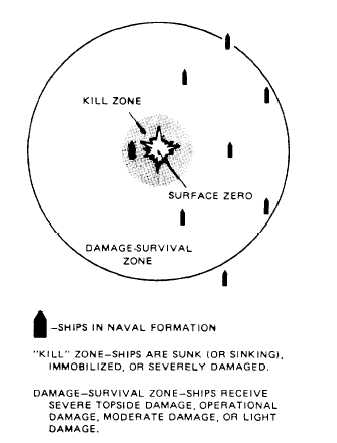RADIOLOGICAL DEFENSE
The detonation of a nuclear weapon creates
a nuclear warfare environment. A nuclear weapon
burst produces characteristic effects that damage
both ship and equipment, injure personnel, and
adversely affect the performance of electronic,
electrical, and communications equipment. Nuclear
and thermal radiation are hazards of a nuclear
warfare environment that are added to those
ordinarily met in conventional warfare. The air
blast and underwater shock effects of a nuclear
weapon burst pose defensive problems of a greater
magnitude than those posed in an encounter using
high explosives. The air blast and released heat
energy of high-explosive detonation cause localized
damage; in a nuclear weapons detonation, these
effects may envelop the entire ship.
NUCLEAR WEAPONS HAZARDS
Nuclear radiation is a hazard to personnel at
distances well beyond the range of lethal damage
from other effects. A ship’s continued perform-
ance depends upon the effectiveness of nuclear
warfare defense actions that are undertaken
during and after a nuclear weapons burst.
Personnel injuries may result from the nuclear
weapons effects of air blast, underwater shock,
thermal radiation, and nuclear radiation.
DAMAGE-SURVIVAL ZONE
The damaging effects of a nuclear weapons
attack generally decrease in severity as distance
from the burst increases. As shown in figure 7-5,
a kill zone surrounds surface zero; ships in the
kill zone will be sunk, immobilized, or severely
damaged. Outside of this zone is a much larger
damage-survival zone in which ships will receive
severe topside damage, operational damage,
moderate damage, or light damage. The size of
each of these zones depends primarily on weapons
yield. The damage-survival zone is not only much
larger than the kill zone, it is also much more
important from the standpoint of modern naval
formations. This is because most of the damaged
ships in a modern naval formation probably will
be located within the damage-survival zone.
NON-NUCLEAR EFFECTS
A brief discussion of damage by non-nuclear
effects is given below. Table 7-7 summarizes the
Figure 7-5.—Damage-survival zone.
possible types of damage that can result from air
blast, underwater shock, or water waves.
Damage by Air Blast
An air blast is the name given to the pressure
pulse created in the air by explosion. Air blast
from a nuclear detonation can cause general
damage up to 10 miles from the burst. The time
required for the damaging effects to reach a ship
may range from seconds to about 1 minute. Air-
blast damage primarily will be inflicted on the
superstructure and the hull above the waterline.
Surfaces that are nearly parallel to the air blast
will be damaged less than those that are nearly
perpendicular to it.
Damage by Underwater Shock
Underwater shock is the name given to the
pressure pulse created in water as a result of an
explosion on or below the water surface. Shock
from a nuclear burst is similar to that resulting
from a depth charge. It can inflict severe damage
7-20


